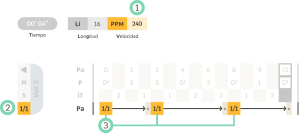Temporal fractions
What is a temporal fraction?
Temporal fractionation is a function that allows us to modify the velocity by means of an arithmetic fraction. When this fraction is applied to the timeline, the pulsations are divided and grouped, generating a new velocity that can be faster or slower than the original one.
Fractions generate new pulsations (pls)in relation to the reference pulsations. These fractional pulsations, which we differentiate with a new numbering, are related to the reference pulsations through a cycle. In this cycle, the two velocities corresponding to these two pulsations (the velocity set by the metronome and the velocity generated by the fraction) coexist, coinciding every so often.

THE FRACTION
The perception of time and velocity is flexible and subjective.
To modulate the velocity in the Nuzic system we use arithmetic fractions.
An arithmetic fraction expresses the relationship between two numbers, the numerator and the denominator. To obtain the result, the division of the fraction is carried out, dividing the numerator as many times as the denominator indicates. The result is a rational number.
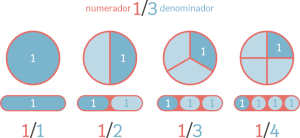
Our daily life is full of fractions; for example, time expressed on a clock relates the different units of time (hour, minute, second) through fractions:
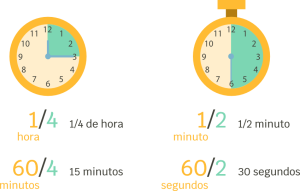
In arithmetic the same fraction can be read in two different ways, both with the same result:
- The denominator indicates how many parts we divide the basic pulsation into (subdivision) and the numerator indicates the number of fractional pulsations we choose (grouping).
- The numerator indicates the number of pulsations on which we will apply the fraction and the denominator indicates how many parts these pulsations are divided into.This is the way we use in Nuzic.

FRACTIONS ON THE TEMPORAL AXIS
In the case of the temporal axis, the numerator indicates the number ofpulsations (pls) on which we apply the fraction and the denominator indicates how many parts they are divided into.
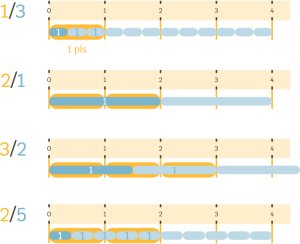 |
audio  
audio  
audio  
audio   |
We differentiate the new fractional pulsations with a decimal number:
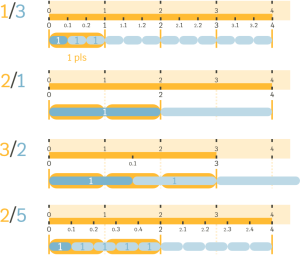
Depending on the type of fraction and where it is applied, it can cause acceleration or slowing down.
A temporal cycle can be defined as two velocities that coincide every so often.
The fractions generate cycles that relate the velocity of the metronome to the velocity of the fractionation. For the duration of the fractionation, these two velocities are synchronized at one point on a regular basis. This point marks the end or beginning of the cycle.
Cycles, which may or may not be repeated, function as temporal units whose length is always equal to the numerator of the fraction. When using the Nuzic app, all fractions have to complete their cycle. For this to occur, there must be a proportional relationship between the total length of the segment and the length of the section where we have applied the fraction: the numerator, which determines the length of the cycle, must be divisor of the length of the fractionated section. Or, viewed another way, the length of the fractional section must be a multiple of the numerator.
CHANGES IN VELOCITY
We can modify the velocity of a musical idea in three different ways, expanding the rhythmic possibilities:
- Changing the PPM (affecting the whole idea)
- Changing the voice fraction in a fixed way (affecting the whole voice)
- Changing fractions punctually (within a segment)
- Combining the second and third options (voice fraction + punctual fraction)
